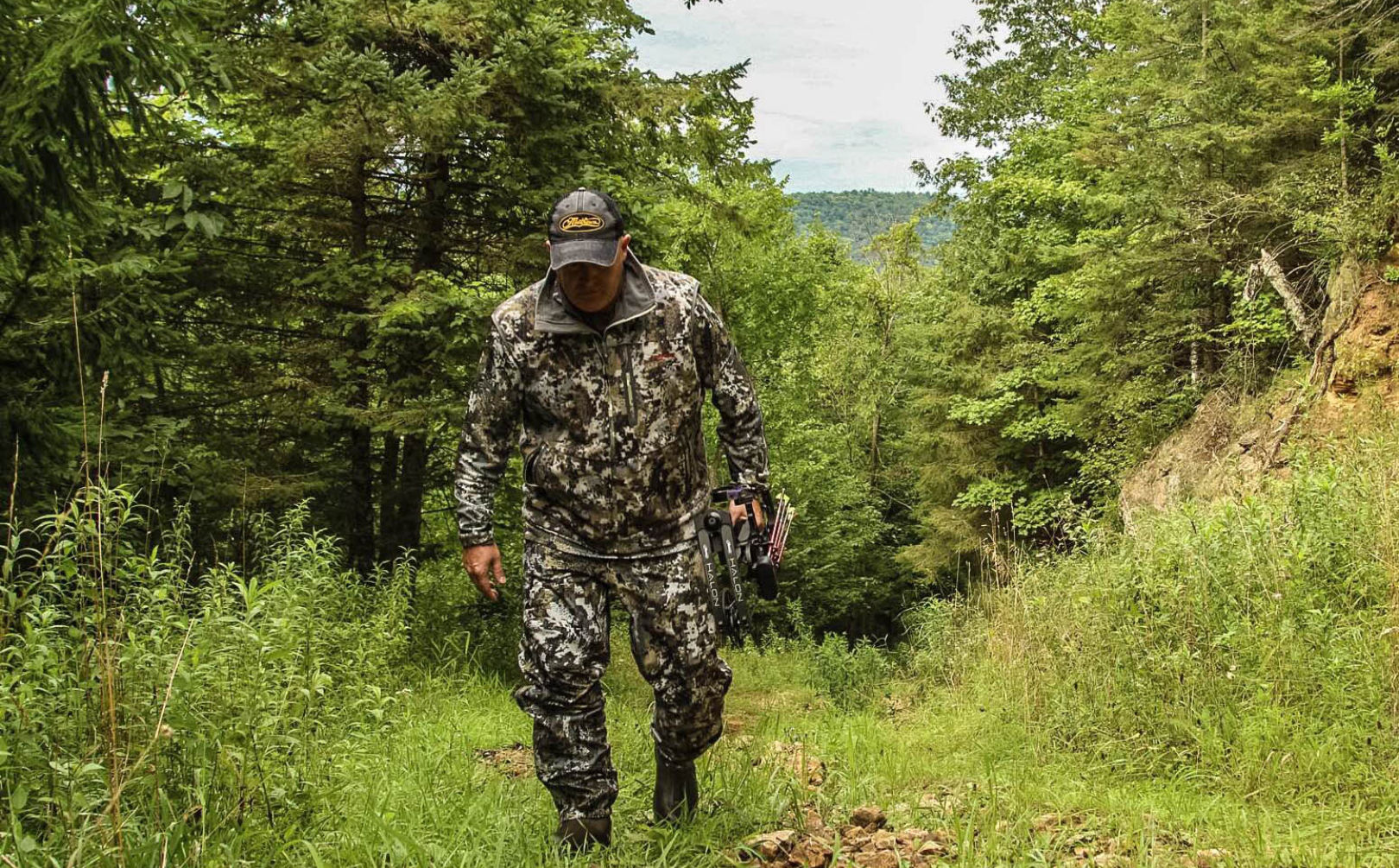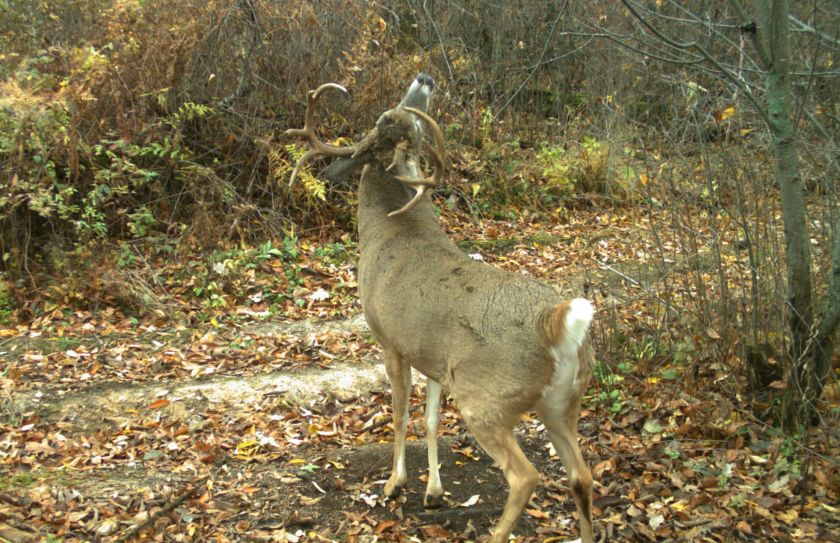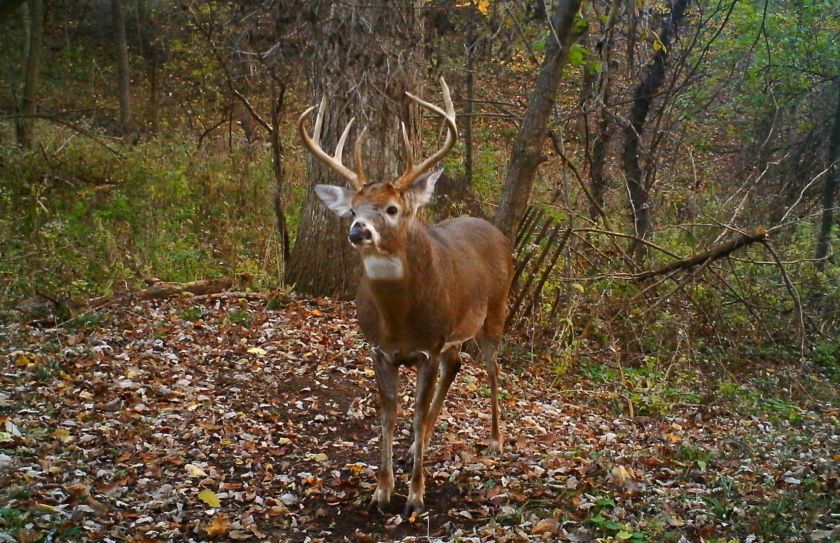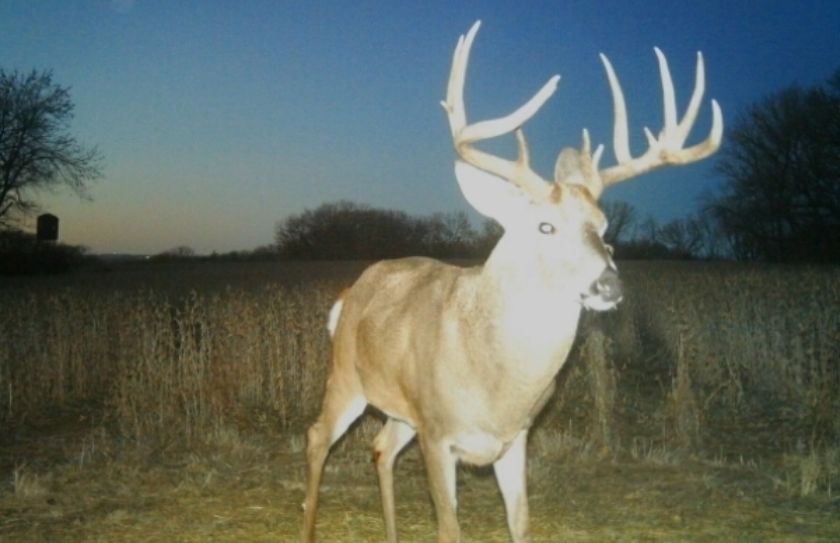
As the soft put-put-put of the ATV started on the neighbor's land, I knew it wouldnt be long before a herd of deer would shoot through the heavily wooded river bottom. In fact I looked forward to it! The date was in 1991, and if it wasn't for the misses, mishaps, and blunders, 1991 would have been the year of my first Pope and Young class buck-but that's another story. Instead, for two years I had been enjoying the morning start of the ATV approximately 1/2 mile away to my south/southeast, followed by the reliable Easterly movement of the machine down the road, and finally a North turn into the south side of the same wooded riverbottom that I sat along almost mile away to the West/Northwest.
Deer numbers were high in MI's thumb area during the early 90s and I believe the highest number of deer that came through because of my neighbors unplanned deer drive was 26. It was during one of those deer drives that a 20" wide 11 point that I had watched all summer long offered the perfect broadside shot at 15 yards, at which time I missed. Later I learned that all those early hunting year blunders equaled experience, and that those experiences would ultimately lead to success in later years but even if I had been explained that at the time it still would have stung. In fact, I still feel the pain of that missed opportunity and several others. That pain is what I am writing about this morning, 23 years later: The pain of experience, many times bad, that has honed the way I approach virtually every hunt today. And although this is NOT an article about the negative influence of ATV'n to your favorite deer stand, its amazing how decades later nothing has changed.
I am going to take you through the process of what I go through, starting from the truck, that based on my experiences has now given me the best chance for success each time I enter the woods. That process may sound rigid, it may sound quirky, but experience has been a faithfull teacher and this is the best I've come up with so far. I've written often and I will write it again that a mature buck is an independent thinker. As an independent thinker an individual buck has a personality, has an attitude, and has learned to figure things out on his own. His own experiences have shaped the way he responds to any intrusion into his world, and in the end you are left with a battle of "experience vs. experience". If you read along, I'm hoping to throw a little more ammo of experience, your way. A rigid scent control regime, great camo, mock scrapes and the lates and greatest gear can not overcome low-impact hunting efforts designed to help you hunt like a predator, instead of a human.
1. The Truck: It could be from your cabin, truck, car, or even your boat but it critical that you do not forecast your presence in the woods.
Think Predator. Even though you personally know that you are going to walk and eventually climb into a stand, it's great to keep that little secret to yourself. Sound travels considerably! How many of the local deer know various hunters are coming into the woods, before that hunter is even 10' from his truck? Banging, clanging, talking, coughing and any other unnatural noises can ruin your hunt before you even hide the keys on your gas cap (please keep that little secret between us!). Deer are creatures of habit and that includes both their habitats, AND your habits.
Picture a cabin on the road, a 40 acre parcel, a food plot directly behind the cabin and a back porch. The light flips on the porch about an hour before sunrise, the hunters come out and get dressed scent-free, and then enter a now deer-less woods. It could be as subtle as a cough, the metallic clang of a bow cam against the bed of the pickup, or as intrusive as the light flipped on the back porch before a pre-dawn stalk, but either way it can spell the end of a good hunt, before it even begins.
2. The Walk-in: If it goes swish-swish-swish or squeak-squeak-squeak, why buy it?
Look at it this way, if your hunting buddy can stand on hard ground facing away from you, and you can walk up close enough to smack him on the back of the head while all geared up for a sit-its quiet enough to use in the woods. Leaves crushing and an occasional sticks breaking are all natural noises in the woods. The effect of natural noises can all be deminished easily if you break your cadence with irregular steps and frequent stops, and you can previously removing any dead limbs. Lets face it, we dont have the light soft steps of a bobcat in the woods, so its critical we dont add to the noise. I have talked to many hunters about cleaning their trails into their stands, and I have seen some great hunter access paths! However, if your equipment and clothing is not quiet first, even a down-to-the-dirt "quiet trail" isn't enough.
Its happened a few times over the years, but how many of you have spooked deer from a mile away across an ag field when you simply flipped on a flashlight to make sure of your next step? I first did in the late 80s, and it taught me a valuable lesson. I still remember feeling really bummed that I possibly ruined my hunt for the day. I think many of us have done it throughout the years, and we didn't even realize we did it. Those darn fancy headlamps that guys use now are even worse, built with modern bulbs and batteries that I swear carry enough light to land a plane with! We dont share the quiet step of a predatory cat, or the have those big night eyes to guide our way so its very important to use a light when we have to. As a general guide though, if you can see it from an altitude of 30,000 feet, its probably not subtle enough. My preferred light is still my collection of old-faithful mini-mags, with 1/2 of the lens covered by my thumb when light is needed...just a sliver of light, that is.
3. The Entrance: I will keep this short and sweet, but if you enter your stand within shooting distance of a field edge, try and enter the stand at a point where you can shoot a deer.
The reason? Because while many deer walking a field edge might not pick up where your clean rubber boots have stepped on soil or short sod, they sure might pick up a spot where you turned into a stand location if it hasnt been carefully groomed. I like to remove all debris in the form of grasses, weeds, young woody growth, etc the closer to the stand that I get. Its a real bummer to have that mature buck hit your entrance with you waiting at full draw for him to step a few more paces, just outside of your shooting lane. That thought extends to all aspects of your entrance, whether on your walk in or much closer to your stand....any branch, tree, weed, or leaf all have the potential to be a sponge for your scent or scent trail and should be avoided as best as possible while walking in.
4. The Climb: After you have blended into the woods on your approach, and all unnatural noises have been kept to an absolute minimum, its important that your climb into the stand is a continuation of the process, and isn't the end of it.
This is where if your feathers havent been ruffled yet, they might be now-so proceed with caution. I've used a climbing stand to shoot mature bucks when bowhunting, but not often, because they just aren't quiet enough for me to use on a regular basis. Like I have in the past and will again this year, I will use a climber on public land. Often the possibility of theft or a last minute change of deer movement may happen as well, but if you don't have to use one, I certainly wouldn't choose to use one.
But the climber is only the first thought. Squeaky climbing sticks or ladders can broadcast your ambush spot for hundreds of yards, let alone a noisy seat or platform. For some perspectiive, think of this situation on another level: As a Life or Death moment as a military sniper.If the enemy could be within a few hundred yards, would you settle into an ambush with noisy gear, banging weapons, or loud clothing to announce your location? No way. Its the same with a whitetail deer, especially the independent thinking mature buck, only, there are a couple of differences: He can hear several times BETTER than a human, and he is certainly pre-wired to view you as the enemy long before he even understands through his experience to do so.
5. The Sit: I will admit it takes a few sits for me to get deer ready every year to slow my reaction time to a minimum.
I've experienced early season deer stand whiplash on several occasions when the sharp break of a distant stick has caused my head to turn so fast I literally felt the pain. Maybe it is a summer full of kids, work, and non-deer life-but it takes a while to slowly and quietly fall back into the hunting season.
The beginning of the season is one thing, but the middle is another. How many of you have learned to be able to tell the difference in the step of a cautious fawn, from a squirrel, from a raccoon, from a roughed grouse? What about the difference between the step of a mature buck and an approaching doe family group? I find the older I get, the more I hunt with my ears. It is interesting how even though I experience much less whiplash than during my younger years, the aches and pains of a long season seem to take their toll on my neck and upper back more than ever! Maybe that is a good thing? The older I get, the more I am forced to move more quietly in the stand. It pays to close your eyes and to learn to identify the difference between the light steps of a ruffed grouse, and an approaching deer in the distance...it is amazing how the two actually sound the same!
6. Subtle movements seem to be obvious, but think of this, how many seconds are you away from a shot?
A mature buck walking by will grant you a slight amount of movement, so with that being said, how many seconds are you away from taking a shot? 15 seconds? 10 seconds? Personally I like to be ready within around 5-8 seconds, to have the bow pulled back and to start the aiming process with an eventual shot taking place in less than 10 seconds. In order to do that, for me, that means an upright bow whether the bottom cam is resting on the platform on the stand between my legs, or hanging in front of my face by limb or bow-hanging product. Also, that means that there is no facemask to change the position of, no gloves to adjust, nothing to move out of the way, and that my release hand is always resting close to the knocking point. And finally, it is important to know what a mature buck looks like at a glance by recognizing sagging backs or bellies, huge chests, dark coats, dark antlers, the attitude, the walk and last but not least, the shear mass or size of antlers. Your judgement should be a split second look, and then you begin the process of creating a shot opportunity. In most areas the difference between a 3 year old and a yearling or 2 year old is incredible, but the difference between a 4 year old and the younger bucks is amazing. At this point I dont care if he is 5, 6 or 7, I am probably shooting long before the time it takes to be definitive.
What is a great way to practice judging in the field? Forget the posters, the jawbones, bellies and backs! Instead, watch hunting videos, and watch a lot of them. My young kids were never trained to "poperly" field judge a buck and probably will not be unless they become field research biologists for a large whitetail ranch. But my kids can sure tell the difference between a mature buck...and a non-mature buck! From watching 100s of bucks on DVDs and hunting shows, they are extremely good at "field" judging within a second or two. It has to be a feel...often in a real world hunting situation you have less than 10 seconds. And that's not 10 seconds to judge the animal, that's less than 10 seconds to judge, ready for the shot, and take the shot without the buck knowing he is being hunted. With several of my largest bucks harvested during archery season, I didn't realize that they were the largest buck we were after, until I walked up to the expired beast. They were simply a mature buck and I took the shot. Considering that I have shot less than 10% of my mature bucks on a food plot, I have learned that it pays to be ready very quickly in the woods, where bucks are are often moving and rarely stand still. And most importantly? If you are ready...you are quiet! A cougar sitting on a rock ledge waiting for game to walk by doesn't have to study his prey for 30 seconds, or reach behind him to grab his weapon. He is quietly waiting and deadly at a moments notice, and so should we.
7. The Handwarmer: During my whitetail sits, I faithfully use a handwarmer tube during any temperature.
Not only do I expect a handwarmer to keep my hands warm, but to wrap my facemask and hat under for the walk, to hold my grunt-tube, my cell phone, thin gloves, and if it has a zippered pouch I put all of my muzzleloader necessities inside as well. But aside from being a carrying pouch, it does what it is supposed to do: It keeps my hands warm while on the stand in the worst of temperatures! I change my gloves to very thin ones for my sit, while placing my heavy gloves used for the walk in within my jacket/bibs to add an extra layer of insulation to my chest area. I also wrap a gore-tex leg gator around my handwarmer for the ultimate level of protection and warmth in the most extreme weather conditions.
Having all of my necessities within very close reach has been an added benifit to the handwarmer that I didn't imagine during the mid-80s when my mom actually helped to create one for me with several layers of wool and a giant safety pin. My hands froze while standing on a branch in my "tree stand" and I wanted to keep them warm-a lot warmer! However, whether it be my grunt call or muzzleloader necessities, what was originally a great way to avoid frostbite turned into a very quiet and convenient carrying pouch.
8. The Descent: The sit is over, but you are still in the woods!
Even though breakfast, lunch or dinner may be calling, the same low-impact practices still apply. Removing all unnatural noises from the process of the hunt is just as important during the climb out, as it is during the climb in. In fact, the exit is highly underated. Think of your exit as being your best effort at preserving your future sits. Have you ever considered how many deer are spooked a few hours after your walk out when they smell where you hands or hair touched branches, grass or the bottom of your stand? Mature bucks wander many miles, freely under the cover of darkness so it could be said that you have a better chance of spooking a whitetail under the cover of darkness with leftover scent, then during the daylight. It pays to never let them know that they were even being hunted, and that includes after you leave the stand as well.
I avoid backpacks for a couple of reasons:
1. They can end up being a bulky catch-all that adds a lot of discomfort to a 30 minute walk in or out, let alone an hour or more one-way.
2. A backpack typically equals NOISE. Snaps, buckles, Velcro, zippers and even the potential fabric scrape while you attempt to duck under a branch or fallen log.
Often backpacks only add to the "spook factor" of an otherwise successful entrance or exit to a stand location, in particular during the rush of wanting to get back to a warm truck. Even when I trek over into the recesses of public land, I still leave the backpack behind in favor of using a few pockets. I find that my access is quieter, and it forces me to worry about only the necessities of the hunt. My only exception? When I will carry a video camera into the woods.
The same practices that you employed to start your hunt should be used on the way out. Think long-term. The hunt for the day may be over, but the hunt for the rest of the season may be just beginning. In all that you do, try to leave as much future hunt in the lands that you hunt, as possible.
Conclusion
Put-Put-Put, the soft purr of the ATV started at the neighbors and the old feelings rekindled. The date though was now October of 2011, and the place, in southwest WI. Still more than 600 miles away and a full 20 season later the outcome would be the same. Blowing deer, spooked deer, and running deer. Only this time there were 2 ATVs, and they would drive through the entire 50 acres of woods, on the various network of switchback trails to access the top of the steep north facing slope that stood 500 in elevation above the valley below. Over the previous several years we debated back and forth if it's better to have neighbors that spook most of the deer off of their property, and rarely touch any of the area giants -OR- a hunter or two that attempt to manage the herd, improve the habitat, and both grow and shoot mature bucks often. Of course we would probably choose the later if we could, but over the years we have learned to use our neighbors high-impact intrusions to our low-impact advantage.
Sometimes a few of the widely accepted acts of hunting, really pale in comparision to many of the little things. However, as picky as some of these practices may seem, many I've learned the importantce of throughout years of making my own mistakes while chasing mature bucks. There are many hunts that are over before a hunter leaves his truck, enters the woods with an ATV, or has yet to travel the remaining 100 yards to his stand location. By paying attention to a few details, I hope that your next hunt can be over with the pull of a trigger instead of the turn of a key.


